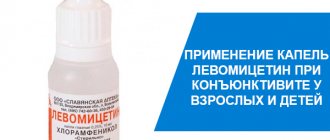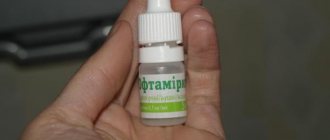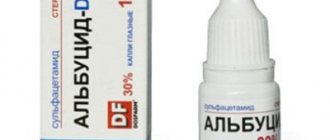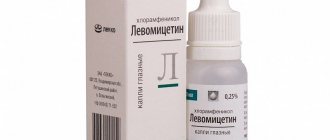Indications for use
What does Levomycetin help with:
- blepharitis;
- conjunctivitis;
- keratitis.
According to the medical practice of ophthalmologists, drops can get rid of any infectious eye diseases caused by pathogenic microorganisms sensitive to the action of chloramphenicol.
In addition, the use of drops is advisable if other ophthalmic agents do not have the desired therapeutic effect.
Instructions for use of Levomycetin
According to the instructions, different forms of the drug are used in their own way. The duration of the course and dose are determined by the attending physician based on the diagnosis, symptoms and age of the patient.
The treatment regimen depending on the type of antibiotic is as follows:
- Eye drops - as a rule, use 1 drop up to 3-4 times a day for 5-15 days. After the procedure, you should press the outer part of the eye with your finger and prevent movement of the eyelids for 30 seconds. Drops can also be prescribed for purulent otitis media. The course of treatment is twice, 2-3 drops in each ear canal.
- Tablets - indicated for patients with various infectious conditions. The duration of treatment is no more than 10 days. 1-2 tablets are prescribed up to 4 times per day. The highest dosage is 500 mg per day. In severe cases, according to individual indications, the dose can be increased by the doctor to 3-4 g.
- Solution - intended for external use. Lubricate the skin with the medicine and apply an occlusive dressing on top. If there are cracks around the nipples, they are treated with the product after each time the baby is applied to the breast. The course is no more than 5 days.
- Leniment - applied to the affected dermis in a therapeutic dose prescribed by a doctor. Lubricate the skin with a small layer of the drug and cover with a gauze bandage. It is prohibited to use more than 750 mg once, the daily norm is 1-2 g.
Reviews
To understand whether Levomycetin drops are effective in the treatment of ophthalmic diseases, we recommend reading real reviews from doctors and their patients:
Mlinarov E.S., ophthalmologist:
Time-tested ophthalmic drops. They act quickly and are effective in the fight against conjunctivitis. At the same time, they are more than affordable. In my practice, I quite often prescribe Levomycetin to patients in the form of drops. I am satisfied with the result of the therapy.
Karpov L.D. ophthalmologist:
One of the most common eye diseases is conjunctivitis. Moreover, children suffer from it more often. Conjunctivitis can be easily contracted by simply rubbing your eyes with dirty hands. Levomycetin drops are a powerful antibiotic, the active substances of which instantly penetrate the eye tissue. The therapeutic effect is observed after a short period of time. In most patients, therapy is not accompanied by adverse reactions.
Ekaterina, 29 years old, St. Petersburg:
I used levomycetin for a long time, it helped cure the advanced stage of blepharitis. During pregnancy, I encountered the problem of conjunctivitis and knew that I had a reliable assistant in the form of antibiotic drops. I was very disappointed when my doctor said that Levomycetin is contraindicated during pregnancy. Therefore, I was forced to replace the time-tested remedy with a similar drug that was approved in my situation.
Vladimir, 32 years old, Chelyabinsk:
The drops are good, but with frequent, long-term use, my eyes become itchy and I want to scratch them. It is necessary to replace Levomycetin with a more gentle ophthalmic agent.
According to reviews, Levomycetin drops can actually cope with eye diseases. However, adverse reactions may occur, and it is also important to consider contraindications.
If it is impossible to use Levomycetin, therapy should be carried out using lighter drugs.
Pharmacological properties
Pharmacodynamics.
Levomycetin is a broad-spectrum antibiotic: effective against many gram-positive and gram-negative bacteria, rickettsia, spirochetes, pathogens of trachoma, psittacosis, lymphogranuloma venereum; acts on strains of bacteria resistant to penicillin, streptomycin, sulfonamides. Weakly active against acid-fast bacteria, Pseudomonas aeruginosa, protozoa and clostridia. Resistance of microorganisms to chloramphenicol develops relatively slowly. In normal doses it acts bacteriostatically. The mechanism of the antimicrobial action of chloramphenicol is associated with a violation of the synthesis of microbial proteins.
Pharmacokinetics.
The drug penetrates well into body tissues and fluids; therapeutic concentrations of chloramphenicol when administered topically in eye drops are formed in the vitreous body, cornea, iris, and aqueous humor of the eye; The drug does not penetrate into the lens.
Clinical characteristics.
Side effects of Levomycetin
The use of Lemomycetin for therapeutic purposes may cause the following side effects:
- Dyspeptic disorders.
- Changes in the circulatory system.
- Headache, hearing and vision impairment, decreased olfactory function, also frequent depression, neuritis and poor consciousness.
- Symptoms of an allergic reaction.
- Dermatitis.
- Collapse.
Eye drops rarely cause these symptoms. However, they can provoke a hypersensitivity clinic.
Is it possible to drip Levomycetin into a cat’s eyes?
Speaking about the possibility of topical use of Levomycetin in the treatment of eye infections in cats, it should once again be noted that it is necessary to clearly establish the bacterial nature of the disease or the presence of a real risk of developing a bacterial infection.
Don’t worry that your cat will be in pain, because the procedure for instilling Levomycetin in the eyes is painless and will not cause pain.
At home, this manipulation should be carried out as follows:
- Prepare in advance - open the bottle, shake its contents, take and place in front of you several cotton pads, a container of clean boiled water, slightly warmed up in advance, a herbal decoction (for example, you can use chamomile or calendula) or saline solution to clean purulent formations.
- Take the animal in your hands and place it on your lap so that the “instruments of torture” remain behind the cat’s back.
- Try to calm your pet (it is best to carry out the procedure when the cat is half asleep), pet him, talk to him in a quiet and soothing voice. Do not let your cat scratch its eyes, this will cause additional irritation to the mucous membrane.
- Using a cotton pad soaked in warm water or herbal infusion, first moisten and then gently wipe your cat's eyes to completely clear them of pus and mucus.
- Pet the animal again and let it relax.
- Acting quickly and decisively, pull back the cat's lower eyelid and drop the drug under it. Make sure the medicine gets into the eye sac. After such a manipulation, the cat will first experience fear and indignation, and after a few seconds - a pronounced burning sensation. Be prepared: it is very important to hold the animal in your hands and not let it escape. If possible, apply the drops to the other eye immediately, but if necessary, wait until the cat calms down a little.
- After instillation, it is important to continue to hold the animal in your arms for a while so that the medicine begins to act. During this time, the cat should not be allowed to shake its head or scratch its eyes.
Video: how to put drops in a cat’s eyes
Analogs
There are several drugs analogues of Levomycetin that will come to the rescue if the original cannot be used in therapy. Among the best analogues are Syntomycin, Levovinisol, Chloramphenicol.
Do not forget: if it is necessary to replace Levomycetin with a similar drug, it should be selected by a specialist. Self-medication is unacceptable!
- Sintomycin. Russian analogue based on the substance chloramphenicol. Belongs to the group of antibiotic drugs, used in ophthalmology. Prescribed in the treatment of bactericidal eye infections (conjunctivitis, keratitis, blepharitis). Syntomycin is contraindicated in cases of pathologies of the liver and kidneys, or hypersensitivity of the body to the components of the composition. Use with caution in the treatment of patients with skin diseases (eczema, psoriasis, fungal infections) who have undergone chemotherapy, during pregnancy and lactation.
Available in the form of drops and ointments. The cost for a 25 ml bottle ranges from 45 to 60 rubles (depending on the region).
- Levovinisol . The drug belongs to the group of antibiotics used in ophthalmology. The composition is based on the substance chloramphenicol. Indications for use: ophthalmological diseases, including those of a bactericidal nature. Drops are contraindicated in case of hematopoietic disorders, severe skin lesions, pregnancy, or breastfeeding.
The approximate cost is 35 rubles for a 10 ml bottle.
- Chloramphenicol . An antibiotic based on the substance of the same name, chloramphenicol. Drops are prescribed for the treatment of infections in ophthalmology. The drug is prohibited for use in cases of severe liver and kidney damage, eczema, psoriasis, a tendency to develop allergic reactions, hematopoietic disorders, hypersensitivity to the components of the drops. May be prescribed with caution to pregnant and lactating women.
It goes on sale in bottles of 5 and 10 ml. The price ranges from 25 to 60 rubles.
All presented analogues are approved for the treatment of eye diseases in children from four weeks of age.
Before starting therapy, you should consult with an ophthalmologist and pediatrician.
If you compare the original and its analogues, you will notice that the main active ingredient and indications are identical. At the same time, Levomycetin has a more attractive price (compared to generics).
Levomycetin is an antibiotic used in ophthalmology. Despite the low cost, the drops have received a large number of positive reviews from both doctors and their patients. Do not forget that ophthalmic drops have a powerful effect on the body.
It is unacceptable to exceed the prescribed dose! This will not lead to a faster recovery, but may cause an overdose.
Is it possible to use Levomycetin during pregnancy?
As follows from the instructions for the drug, as well as based on information about the toxicity of the active substance of the drug, the use of injection and oral forms of the drug while expecting a baby is categorically unacceptable.
Levomycetin during pregnancy - use in the early stages
The first weeks of gestation lay the foundation for the health and successful development of the baby in the next 9 months of pregnancy. Interference in this process is highly undesirable. If we are talking about Levomycetin, its use in the first weeks of gestation is unacceptable under any circumstances. The result of therapy will most likely be intrauterine death of the baby or pregnancy failure.
Levomycetin during pregnancy - use in the 2nd trimester
The second trimester has arrived, the baby continues to grow and develop, the placenta has formed - a barrier between the baby and substances entering the pregnant woman's body. But even such protection as the placenta is not able to protect the baby from the toxic effects of chloramphenicol. Taking Levomycetin by a woman during this period of bearing a child most often leads to pathologies in the development of the baby’s body systems (including possible brain damage - encephalopathy).
Levomycetin during pregnancy - use in the 3rd trimester
The ban on the use of Levomycetin even in the final stages of pregnancy is due to the fact that the baby’s immature liver and kidneys are not able to fully “filter” and remove the drug substance. The baby’s heart and circulatory system are also exposed to toxic effects. As a result, there is a high probability of developing “gray syndrome”. The pathology is not diagnosed while the child is in the womb. Organic lesions that are provoked by Levomycetin may be incompatible with life. You should not take risks and use such a dangerous drug during this period.
Attention! Drinking Levomycetin during pregnancy, as well as administering the drug by injection, is strictly prohibited.











